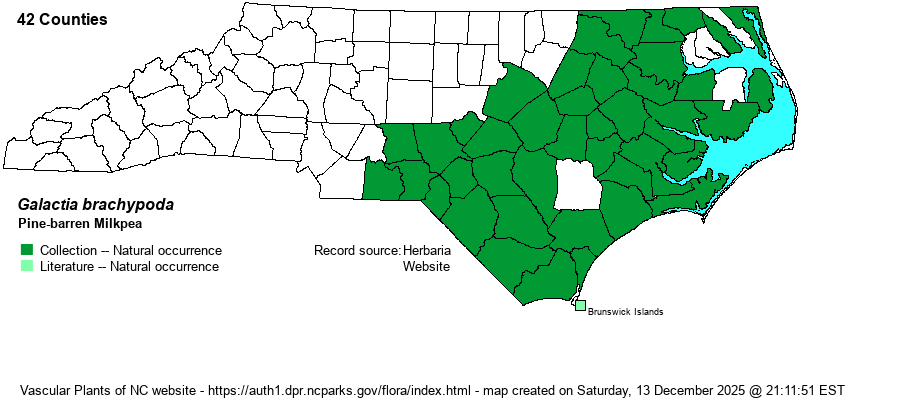| Author | Torrey and A. Gray | |
| Distribution | This name replaces what in RAB (1968) and other publications was known as G. regularis. See the paper by Nesom (2015) for details. It is limited in NC to the Coastal Plain and lower Piedmont, where it is present in nearly all such counties.
Weakley (2018) states the overall ranges as "NJ south to s. FL". | |
| Abundance | Common in the Coastal Plain, rare to uncommon in the extreme lower Piedmont. | |
| Habitat | This is a species of sandy woodlands and other sandy and dry sites. | |
| Phenology | Blooms from April to September, and fruits shortly after blooming. | |
| Identification | Weakley (2018) quotes Nesom (2015): "Plants of Galactia brachypoda are characterized by their essentially procumbent habitat with mostly non-twining stems (sometimes weakly twining distally), minutely strigose (antrorse or retrorse) cauline vestiture, subcoriaceous leaflets with raised venation, and relatively large corollas. Plants of G. brachypoda with distally twining stems and relatively small leaves might be mistaken for G. regularis (in the current sense; i.e. the former volubilis), but the latter has climbing and consistently twining stems with looser and non-appressed vestiture, thinner leaves, and longer inflorescences with curved axes and smaller, less congested flowers." In Weakley's (2018) key to the genus, G. brachypoda and G. minor are separated from G. regularis and G. volubilis by the stems "procumbent at least proximally and variously twining, weakly twining, or not twining near the tip"; the other two species have stems that are climbing or sprawling and are twining. This species is separated from the recently split out G. minor by "Several to most internodes (especially those toward the base) longer than the largest leaflet of adjacent nodes; .. leaflets (4-) 10-25 (-32) mm wide; flowers (3-) 5-15 (-25), rarely 1-2" (Weakley 2018). His key says that G. minor has "Internodes only a little longer to usually shorter than the largest leaflet of adjacent nodes; … leaflets (4-) 7-10 (-18) mm wide; flowers solitary and axillary or 2-4". In summary, this is the most common of the non-twining species of Galactia in the NC Coastal Plain. | |
| Taxonomic Comments | For details, see Nesom (2015).
| |
| Other Common Name(s) | None? | |
| State Rank | [S4] | |
| Global Rank | GNR | |
| State Status | | |
| US Status | | |
| USACE-agcp | | |
| USACE-emp | | |

